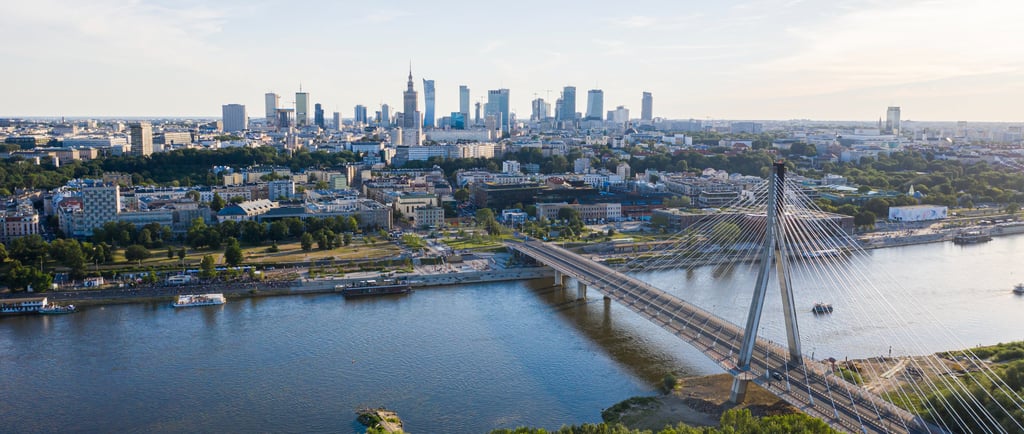Poland: An Upcoming Regional Power?
Poland has been undergoing a significant shift, evolving from its past economic model towards growth in the service, finance, and technology sectors. However, as military spending increases amid regional tensions, will the country’s economic progress be hindered by the potential rise in taxes and a shift in focus towards defence?
POLAND
Augustus Redman
8/16/20244 min read


While sometimes viewed as an impoverished backwater that never recovered from its days as a communist state, Poland has been greatly modernising in recent years.
The country’s service, finance and tech industries have been quietly emerging, and the days of western manufacturing companies seeking Poland’s cheap labour and living costs could be numbered. With Russia’s invasion of Ukraine in 2022, modernisation and western investment in Poland has only sped up, as the country continues to draw politically closer to the United States. The invasion has not completely secured Poland’s future however, and American actions are still the determining factor in Poland’s economic growth. Poland’s rulers are looking to enormously arm their nation (in the face of Russian aggression), and that military dynamic should warrant close attention from any foreign companies interested in Poland.
Until recent years, the county’s slow recovery from its time as a communist state was consistently hindered. Coal mining and steel milling dominated the communist economy, and the quaternary sector was almost completely absent. Poland subsequently suffered a sizable brain drain in its youth migrating west in search of higher paid work. At home, the economy has since been dominated by its cheap and plentiful labour, used by western companies for their manufacturing bases in Poland. A lot of this has been changing in recent years however, as a quaternary sector has been steadily emerging. The tech and IT sectors (along with research and development in general) have been greatly aided in their growth by investment from western companies such as Google, Samsung and Microsoft. Poland’s cheap labour and living costs have been attracting this investment, but the country must build its own tech companies and cease reliance on foreign ones if it is to fully modernise. Poland currently needs foreign assistance in establishing new industries (mostly quaternary ones), but Polish-owned businesses are needed to make the nation a great power in Europe.
Reliance on foreign support for growth is a concept all too familiar to Poland. The country has long been seen as a leech on the European Union, devouring inordinate funds and providing little in return, save for cheap labour exports. This view is becoming increasingly outdated. Indeed in 2014, Poland received €17.1 Billion in EU funds and only contributed €4.2B. In 2023, Poland received €13.47B and contributed €6.47B. Much like its economy, there is still much progress to be made here, but that progress does seem to be consistent. One of the biggest aids Poland has enjoyed in its growth has been the lack of an oligarchy. Unlike most former USSR and Warsaw Pact states, Poland’s new capitalist industries did not fall into the hands of a corrupt few - Its industry, government and military are run competently.
The growth of Poland’s quaternary sector has not been greatly publicised, as it has been largely overshadowed by its increased military spending. The Polish army is expected to expand beyond 300,000 personnel in the next few years (having recently crossed the 200,000 mark). Poland also looks to be custodian of the largest cruise missile inventory in the EU, along with the largest artillery and tank force in the EU. This is not an unwarranted expansion, nor has it been conducted with no foreign help. Quoted in a 2022 article for Politico, a senior US Army official stated: “Poland has become our most important partner in continental Europe”. Poland’s geographic position provides it with the most important avenue for western military aid going into Ukraine (in the form of railways). It will prove an invaluable asset in rebuilding Ukraine if the Zelensky government retains a majority of the country’s territory post-war.
As its infrastructure and geographic position are key, Poland is not merely trying to build a new army - it is trying to build a new industry. Like the other former Warsaw Pact states, most of Poland’s military equipment consists of Soviet-based designs, not NATO ones. If Poland is to make itself even more useful to NATO, the Polish armed forces must go from a Soviet-based army to a NATO-based army (for the sake of easy manufacturing and repairing; spare parts etc). The South Korean and Polish governments have signed numerous agreements to collaborate on designing and manufacturing new military vehicles; tanks, armoured personnel carriers etc. Although South Korea is not in NATO, it is a western-alligned country and the only such state outside the US that has prepared for a Ukraine-like war. Such partnered programs will be the basis for a large domestic defence industry, which could rival the likes of Germany in the future. Even outside of manufacturing, Polish industry is still drawing foreign support in its military tech programs - In February of this year, the Poznan hub for maintenance and supply of US Abrams tanks was inaugurated.
It is this surge in military spending however (along with the war in Ukraine in general), that could become a major obstacle for Poland’s economic modernisation. Poland is currently attractive to western companies precisely because of its cheap labour, housing and standards of living - Taxes are quite low. If taxes were to significantly rise (in order to fund significantly increased military spending), that affordability edge would be in danger of being lost. The foreign investment that Poland’s economy needs in its growth would be jeopardised, and the country’s modernisation slowed. This transformation would perhaps be outright halted if NATO’s prospects in Ukraine were to fail - If Russia takes a majority of the country and a sizable bridgehead over the Dnieper River. Polish military spending would take priority, taxes raised even more, and foreign companies dissuaded from investing in a country that could become the next European conflict zone.
Poland shows great promise from all perspectives. It suffers from no major structural, demographic or societal issues, it is in the EU, is an important US ally and looks to be modernising. Poland’s future, however, will be very closely tied to Ukraine’s fate; whether the former becomes a fully modernised western power or a military-focussed barrack state. Even with Ukrainian victory in the war, Poland needs to stop its brain drain, and eventually wean itself off reliance on foreign companies to grow and modernise its economy. Only the growth and dominance of Polish companies will fully ensure that.
Augustus Redman is a Lead Analyst at Autran Group, specialising in defence and military policy. Redman is currently reading History at Trinity College, Oxford.
Email: aredman@autrangroup.com


